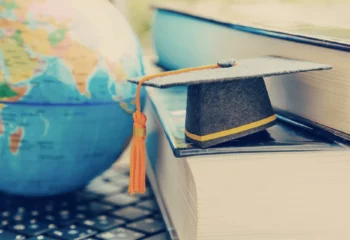“My country is the world, to do good is my religion.”
Thomas Paine
Do young students know the realities of the world they live in? Do they have a global perspective upon which they make their education or focus mainly on national boundaries?
Global awareness is a competency that for some is home taught but for many is school taught. And it is ok both ways as long as the main idea is kept – the ability to navigate and embrace cultural differences. However, even though some of the parents rely a lot on the school to teach their youngsters about global awareness, we also have our part of learning ourselves to be global aware so that we will maintain what our children are taught inside the house as well. Raising a globally aware child is not as easy as it seems, but nothing is complicated with the right mindset and information.
What does a global citizen mean?
In today’s world, a citizen does not mean just what is written in the dictionary. As the world is shrinking upon us, we become one world, and our citizenship membership is globalized.
It does sound great being a global citizen, having an international awareness mindset, being globally aware, living in a globalized world where you have access all over – but all of this greatness comes with a price. Along with its beauty, there are some responsibilities we have. There are more perspectives to see global citizenship from. Some of them are that of mind and that of heart.
From the mind one, it means:
– Being aware of the world we live in.
– Being able to understand that there is more than one reality and more than one language.
– Understanding that we can only be more powerful if we stand together.
– Balancing your reality with other realities that are outside of your own (Nel, N., 2005, Educating Citizens for Global Awareness).
More than this global citizenship mean:
– Being able to respect others’ feelings.
– Keeping a sense of integrity despite the mixture of conflicting emotions one might feel.
– Understanding that each location’s politics affect one’s perception.
– The aptitude to wish the best to other competing countries.
While these seem so easy to understand, it has been proven that as more literate you are, less understanding and heartfelt for others you are. Maybe it is the capitalism of the world that makes us see each other more as competitors than as working towards the same goal – making the world a better place.
This is how global awareness classes can come in handy and teach people what is right and when is right.
With as many benefits come just as many responsibilities. But this is not to frighten you, but to make sure you fully understand how everyone can work together in this globalized world. While being globally aware can be learned and learned from experience, from the boundaries of your home, your family, the global awareness programs taught in the classroom come with their share of needed information and insights.
What does educating global awareness mean?
There are many perspectives on global awareness education as it is a broad topic. First of all, many do not know that it is a rather old term – “global education” came into being in the ’70s. The education system did not focus entirely on it; thus, teachers were unprepared to face fast globalization.
Preparing teachers for a global education make them globally aware, and share their knowledge with their students is a start. One way to do this for teachers is overseas teaching. Another way is to educate national and private schools and allow teachers to bring their global sensibilities to school. And now, this has become one of the worldwide awareness programs for children – overseas learning or international exchanges.
Preparing teachers is the first step, but making sure students embrace a global awareness program must be considered. They have to be open-minded and accept they may not have the proper knowledge or perception of other countries and the world as a whole.
Mainly the global awareness programs teach:
– About other nations and other cultures
– Each young person knows his civic duties and rights both inside his country as well as globally.
– Understand and respect people from different cultures.
– How to work in an international environment.
While this world remained just as big, the accessibility granted by the internet that makes communication lack boundaries makes us feel closer to one another. Thus far, anything that happens in the other part of the globe feels like it happened in the neighbourhood. Moreover, this made us conscious of the importance of global awareness. “Technology reminds us of our commonalities with others beyond our borders” (Nel, N., 2005, Educating Citizens for Global Awareness, p. 26).
With almost no boundaries, the society we live in is a global society. Understanding other cultures will help us shape a more peaceful and just world.
How to incorporate Global Awareness in the education curriculum?
Making the students aware they are engaged directly with real-world issues and activities motivates them to follow a global awareness program. They like authenticity and real-world experiences and are curious to know helpful information.
Some of the most used ways of including the global awareness programs in a curriculum are through:
Bilingual language teaching
A second language or more, speaking it fluently or not, is a great way to help a student see what the world has to offer and see it from another point of view.
Cross-cultural understanding
Culture is one of the most important things a country has and an essential part of its identity. So being able to understand another culture will develop a young person for a globalized world. Taking part in some courses such as anthropology, politics, and trade will help young people understand the international world.
International exchanges
This is one of the easiest ways to understand and get to know another culture. However, it may not be as generic as one could make use of. So, adding the literature part to it, I say, is a must.
Literature
Literature teaching is one of the go-to ways to immerse in another culture.
Global education is imperious in today’s society, and it is an effective way to support student’s social and emotional development.
Various perspectives on Global Awareness programs
A critical view of global awareness programs is that they offer the opportunity to understand and appreciate other countries and cultures. More than this, they are a great way to understand the causes of inequality and injustice and try to fix them. A Global Awareness program is our opportunity to challenge ourselves and our children to get involved in global issues and contribute to change – a good change, by acting locally and thinking globally.
Empathy and understanding of cultural differences are a must when learning to be and become a global citizen. The world gets smaller day by day, and we as humans must keep up with it. Schools have started adding such programs in the curriculum for some time now to raise awareness on globalization, and we are on the right path.
Conclusion
Understanding global awareness is crucial as it is a step forward to understanding that our everyday decisions can impact people’s lives worldwide. With a positive attitude and an openness on the part of young students, the global awareness programs have all the chances to educate them into global citizens.
Despite the tiny gaps that may exist in one place, it is vital to fight for our world as we are all one, and the world is ours. What we choose to learn, to do, to think, and to act today has a direct effect on tomorrow’s world. It may seem too much when you say it, but it is true.
A global awareness curriculum can show us how interconnected we are.




